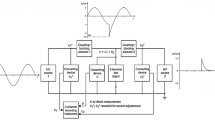Abstract
In order to standardize the DC (direct current) voltage level in low voltage grids, a study is carried out considering the behavior of the human body against different DC voltage levels. The study is based on an analysis that determines if the amount of body current that flows under specific shock conditions is tolerable or not, keeping the current flow time in account. The body impedance is first calculated for two different DC voltage levels with different skin contact conditions. Possible current paths through the human body are subsequently considered to realize the best and worst-case scenario for human contact with live terminal. A relationship between touch voltage and source voltage is defined considering the grounding methods in DC systems. Using ventricular fibrillation curves, the maximum allowable body currents and the associated flow intervals for human bodies are analyzed for the selected voltage levels. The study makes a step further in addressing the feasibility and safety concerns for the standardization of DC voltage level for low voltage installations.
Zusammenfassung
Zur Standardisierung der Spannung in Niederspannungsnetzen wird eine Studie in Anbetracht des menschlichen Verhaltens gegenüber verschiedener DC-Spannungen durchgeführt. Die Studie basiert auf einer Analyse, die bestimmt, ob der Körperstrom unter Berücksichtigung der Flussdauer des Fehlerstromes vertretbar oder nicht vertretbar ist. Die Körperimpedanz ist zunächst für zwei verschiedene Spannungen und Hautzustände berechnet. Mögliche Stromwege durch den menschlichen Körper werden daraufhin betrachtet, um den Best-Case und Worst-Case abzuschätzen. Das Verhältnis zwischen Berührungsspannung und Betriebsspannung in Abhängigkeit von der Erdungsmethode der Niederspannungssysteme ist nachfolgend festgestellt. Aufbauend auf den Herzkammerflimmern-Kurven, werden die zulässigen Körperströme und die entsprechenden Flussdauern je nach Spannungsebene analysiert. Die Studie geht einen weiteren Schritt, um Sicherheitsbedenken und Umsetzbarkeit der Standardisierung der Spannung in Niederspannungsnetzen anzusprechen.










Similar content being viewed by others
Notes
The let-go current, as defined in [6], is the maximum current a person can bear and still able to release the conductor using the muscle simulation produced by the current.
Body contact (physical considerations), current path, grounding method and type of contact (direct or indirect).
References
Biegelmeier, G. (2006): Kriterien für konventionelle Vereinbarungen über vertretbare Risiken beim Schutz gegen schädlichen elektrischen Schlag bei Wechselstrom 50/60 Hz. Elektrotechnik und Informationstechnik, 123(6), 571–583.
Biegelmeier, G. (2007): Das vertretbare Risiko beim Schutz gegen schädlichen elektrischen Schlag für Gleichstrom. Elektrotechnik und Informationstechnik, 124(6), 200–208.
IEC 603641-1 (2001): Electrical installations of buildings – Part 1: Fundamental principles, assessment of general characteristics, definitions. 4th edition.
IEC 60364-4-41 (2005): Low voltage electrical installations, Part 4-41, Protection for Safety – Protection against electric shock. 5th edition.
ChunLan, L., SongHuai, D., Yue, X. (2011): Study on equivalent circuit of the human body and it’s transient response against electric shock. In The International Conference on Advanced Power System Automation and Protection.
Dalziel, C. F. (1972): Electric Shock Hazard. IEEE Spectrum.
Dalziel, C. F. (1960): Threshold 50 Hz fibrillating currents. In AIEE Transactions Power App. System, 79/3/50 (pp. 667–673).
Roberts, D. (2010): 50 V Shock Hazard Threshold. IEEE Transactions on Industry Applications, 46(1).
Nabours, R. E. (2009): Dalziel Revisited, Electrical Parameters affecting ventricular fibrillation. In IEEE Industry applications magazine.
IEC 60479-1 (2005) Effect of current on human beings and livestock – Part 1: General aspects. 4th edition.
Barrett, M., O’Connell, K., Sung, A. C. M. (2010): Analysis of transfer touch voltages in low-voltage electrical installations. Building Serv. Eng. Res. Technol., 31(1), 27–38.
DIN VDE 0100-410 (2007): Errichten von Niederspannungsanlagen, Teil 4-41, Schutzmaßnahmen – Schutz gegen elektrischen Schlag.
Mathworks (2016): Curve fitting toolbox: Fit curves and surfaces to data using regression, interpolation and smoothing. http://www.mathworks.com/products/curvefitting/apps.html. Accessed: July 2016.
Author information
Authors and Affiliations
Corresponding author
Additional information
This work was supported by Hager Group and is part of the research conducted in the research project Research Campus Future Electrical Networks (Forschungscampus FEN) Project 2: Equipment and Network Technologies for Medium-Voltage DC Applications funded by the German Federal Ministry of Research and Education (03SF0489).
Rights and permissions
About this article
Cite this article
Virdag, A., Hager, T. & De Doncker, R.W. Recommendations for standardization of voltage level in LVDC networks based on IEC 60479-1 guidelines. Elektrotech. Inftech. 134, 267–275 (2017). https://doi.org/10.1007/s00502-017-0509-z
Received:
Accepted:
Published:
Issue Date:
DOI: https://doi.org/10.1007/s00502-017-0509-z




